Hollywood’s Biggest Night, Our Biggest Admissions
As the song goes, “It’s a wonderful night for Oscar! Oscar, Oscar! Who will win?” Here at ZekeFilm, there are no  winners and losers, only proud contributors who love to share their thoughts and wisdom on cinema. But, as it turns out, even the most devoted film buffs have glaring omissions in their personal filmographies. So, why not take this opportunity to explore some previously unseen noteworthy films, and write a little something about them? That’s what “Film Admissions” is all about. You can play along at home.
winners and losers, only proud contributors who love to share their thoughts and wisdom on cinema. But, as it turns out, even the most devoted film buffs have glaring omissions in their personal filmographies. So, why not take this opportunity to explore some previously unseen noteworthy films, and write a little something about them? That’s what “Film Admissions” is all about. You can play along at home.
This month, in honor of the 88thannual Academy Awards, to be held February 28, 2016, we have selected the theme of Oscar winning Best Pictures. We hope you enjoy this impressive gathering of pontifications on various big winners, some recent, some not so recent. So grab your tuxedo or ball gown, your fanciest shoes, and your stetchiest limo as we salute Hollywood’s biggest night! This trip down the Oscar red carpet of yore begins with our most recent submission, The King’s Speech, and eventually works its way back to the very first Best Picture winner at the very first Academy Awards ceremony.
I take back what I said before. The winner, dear reader, is you! (Congratulations.) Enjoy these glorious “Film Admissions” as you make your way to the stage to give your acceptance speech. The gold awaits:
The King’s Speech
(2010, The Weinstein Company, dir. Tom Hooper)
by Justin Mory
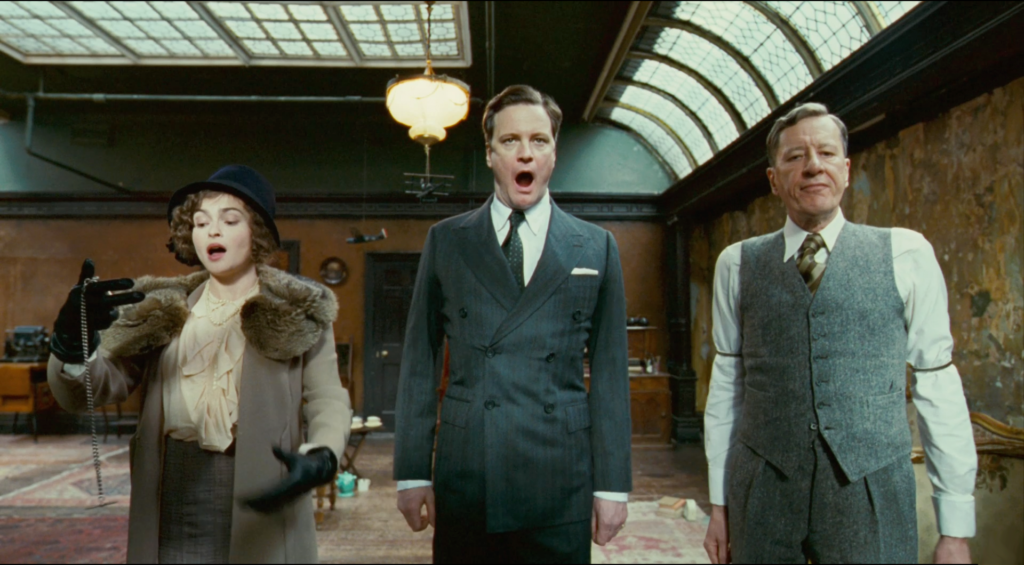
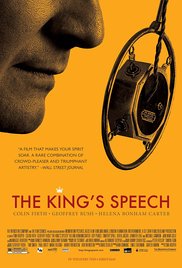 Not to brag or anything (though it will likely appear that I am, anyway), but when it came time to choose an “admission” for the Best Picture Oscar, it turns out I’ve somehow seen every winner from 1927’s Wings right up through 1996’s The English Patient. Which, as it turns out, is a lot of Oscar. (Yes, I’ve even suffered through 1931’s Western soap opera epic, Cimarron; usually the Best Oscar winner no one has seen.)
Not to brag or anything (though it will likely appear that I am, anyway), but when it came time to choose an “admission” for the Best Picture Oscar, it turns out I’ve somehow seen every winner from 1927’s Wings right up through 1996’s The English Patient. Which, as it turns out, is a lot of Oscar. (Yes, I’ve even suffered through 1931’s Western soap opera epic, Cimarron; usually the Best Oscar winner no one has seen.)
Of the four Best Pictures yet unwatched – including 1997’s Titanic, 2010’s The King’s Speech, 2012’s Argo, and 2013’s 12 Years a Slave – my decision was based solely on what I would most likely want to sit through. Titanic, possibly the far greater admission, has reached such a point of cultural saturation that I kind of feel like I’ve already seen it – plus, it’s three friggin’ hours – so, of the remaining three, I chose a tale of the British monarchy, early twentieth century cultural and political history, and the overcoming of a debilitating speech disorder as being most up my alley of award-winning interest.
Opening on the terrifying public spectacle of Prince Albert, Duke of York (Colin Firth) stammering through the closing address at the mid-20s British Empire Exhibition, the film follows the future King George VI seeking grueling physical and psychological treatment from an unconventional speech therapist named Lionel Logue (Geoffrey Rush). Through Logue’s unconventional, but highly entertaining, methods, the bashful royal gradually gains enough confidence to assume the British throne after his elder brother, Edward VIII (Guy Pearce), abdicates and eventually makes a stirring radio broadcast to the British Empire on the eve of World War II.
The working and personal relationship between “Bertie” and Logue is by far the most compelling aspect of The King’s Speech for me, and the centerpiece of the film – the delivery of the titular “speech” – is as much a triumph of friendship as it is a great moment in history. Set to the second movement of Beethoven’s Seventh Symphony, the driving and relentless rhythms of the piece perfectly mirrors the near-flawless diction of the King speaking words of comfort to the realm as trusted adviser Lionel virtually “conducts” his friend Bertie through the perilous ‘p’s, ‘b’s, and ‘w’s.
To build such screen suspense over whether a speaker can make it through approximately 7 1/2 minutes of airtime definitely makes this a worthy “admission” for me; a far greater “admission” might be on the part of the viewer who may feel – or who is quite effectively made to feel – the full terror of the King’s public speaking fright!
No Country for Old Men
(2007, Paramount Vantage, dir. Ethan Coen, Joel Coen)
by Sharon Autenrieth
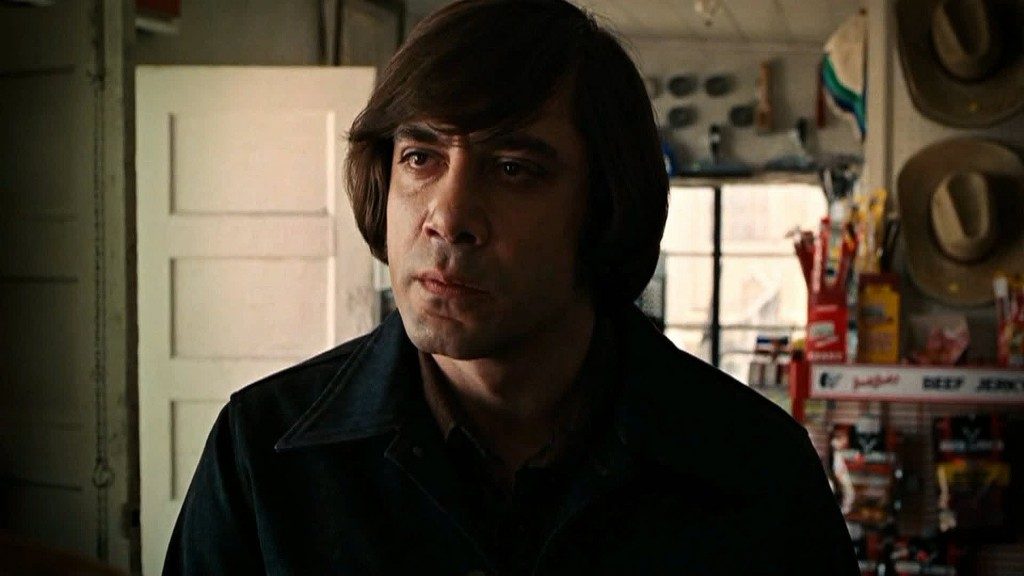
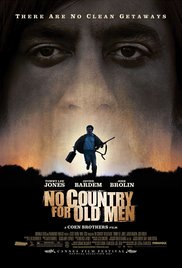 Movies have taught me many valuable things, and among them is this: if I ever find a large stash of money, I should not attempt to keep it. Sneaking off with the ill-gotten gain will not end well for me, I know this: I saw A Simple Plan (1998). I can’t be too hard on Llewelyn Moss (Josh Brolin), though. His story is set in 1980, and he could not have seen A Simple Plan. Moss could not learn from the examples of that film’s unfortunate protagonists that when he stumbles upon a case full of dirty money surrounded only by dead bodies, he should walk away, quickly. He should call the authorities and go home to contentedly live out his life in his rundown trailer, with his sweet young wife.
Movies have taught me many valuable things, and among them is this: if I ever find a large stash of money, I should not attempt to keep it. Sneaking off with the ill-gotten gain will not end well for me, I know this: I saw A Simple Plan (1998). I can’t be too hard on Llewelyn Moss (Josh Brolin), though. His story is set in 1980, and he could not have seen A Simple Plan. Moss could not learn from the examples of that film’s unfortunate protagonists that when he stumbles upon a case full of dirty money surrounded only by dead bodies, he should walk away, quickly. He should call the authorities and go home to contentedly live out his life in his rundown trailer, with his sweet young wife.
That’s not the choice that Moss makes, of course, and his decision to keep the $2 million starts a chain reaction best symbolized by the trails of blood that run through this movie almost from beginning to end. The first time that we see Moss he is a hunter, trying to take down an antelope. As soon as he picks up that case full of cash he becomes the prey for a far more malevolent predator, Anton Chigurh (Javier Bardem). Chigurh is a bounty hunter, sort of. He’s really more of an opportunistic serial killer. Like TV’s Dexter he’s found a way to make doing what he loves into a career. He is also one of the most bizarre and inexplicably grotesque villains of recent film history. His haircut…how best to describe that haircut? Dutch Boy? Prince Valiant? Shaun Cassidy in The Hardy Boys? Whatever you call it, it’s unsettling on top of that hulking frame. Bardem’s Chigurh also has a deathly pallor, dead eyes, and a rictus smile – on the rare occasions that he does smile. The collective effect is clownish, but in the “clowns are terrifying” kind of way.
Much of the movie is a cat and mouse chase between Moss and Chigurh. Moss is resourceful and smart, but not as smart as he thinks he is. I suspect he suffers from a failure of imagination. Yes, he’s a guy with shifty morals (he did abscond with drug money, after all), but he’s basically a decent man. He simply can’t conceive of the kind of evil that he’s up against.
Also on the blood trail is Tommy Lee Jones as a sheriff who is dry, philosophical and very weary – weary of death, weary of bloody crime scenes, weary of the drug-fueled destruction that is changing his West Texas homeland.
Adapted from a Cormac McCarthy novel, No Country for Old Men is a brilliant, dark, nihilistic movie. There are kind, honest people dotting the landscape of the movie – but being kind or honest doesn’t help them, doesn’t offer protection. This is not a world in which virtue is rewarded. It’s also not a world in which evil is necessarily punished. Both outcomes would imply some sort of order, and there is no order here. There is only fate – which is really just a way to look back and name what couldn’t be escaped – and then death.
One Flew Over the Cuckoo’s Nest
(1975, Fantasy Films, dir. Milos Forman)
by Erik Yates

 Milos Forman’s classic masterpiece based on the book by Ken Kesey is admittedly a huge hole in my list of movies I should have seen by now. I am glad to say that I have finally filled that hole. The film, from 1975, still holds up remarkably well. Jack Nicholson gives a fantastic performance as an inmate brought to a psychiatric treatment center to evaluate if he is competent or not. Even though he is mostly sane, he still fits in well with this group of crazies, as he says. The real beauty of the story is how he is better able to help them find healing than the institution can, which is filled with a dedicated staff of professionals who seem to let their ego and pride keep them from seeing their patients as human.
Milos Forman’s classic masterpiece based on the book by Ken Kesey is admittedly a huge hole in my list of movies I should have seen by now. I am glad to say that I have finally filled that hole. The film, from 1975, still holds up remarkably well. Jack Nicholson gives a fantastic performance as an inmate brought to a psychiatric treatment center to evaluate if he is competent or not. Even though he is mostly sane, he still fits in well with this group of crazies, as he says. The real beauty of the story is how he is better able to help them find healing than the institution can, which is filled with a dedicated staff of professionals who seem to let their ego and pride keep them from seeing their patients as human.
Taking place in 1963, it is striking that just over 50 years ago, modern medicine was still practicing such horrific practices as electric shock therapy and lobotomies as a means of dealing with any form of aggression or non-compliance. It took me a while to catch who some of the patients were, even though many of their faces were familiar. The most startling one was a young Danny DeVito, along with Christopher Lloyd who in just a couple of years would re-team up in the classic James Burrows’ directed series Taxi.
Milos Forman didn’t need to embellish the film with moody soundtrack scores to signal a change in emotion, he didn’t need to do anything but roll film and allow the day to day encounters of this group of patients speak to us about the help many of us need and how the pride of individuals, as well as the institutionalism of the self-professing experts can often be the biggest obstacle to healing. Dignity of the individual, and treating others with the same measure of dignity, is still one of the most powerful forms of medicine. It is what makes the ending of this film all the more tragic.
The Godfather: Part II
(1974, Paramount Pictures, dir. Francis Ford Coppola)
by Robert Hornak

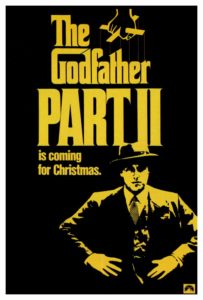 You’d like to say Michael Corleone has his father’s eyes, only you can’t really see his father’s eyes. Gordon Willis made sure of that. But in this sequel-that’s-also-a-prequel you can see everyone’s eyes just fine, and maybe that’s the most basic reason why the movie doesn’t seem as grandly totemic to me as the original. Michael is precise, feline, then explosive in spots – we see the machinations, the Michaelvellian moves, if you please, and we see it all in his eyes, the windows to his ambition. But a fully-lit face means there’s not the same sense of unknowable, melancholic danger in his presence as there is in Brando’s. In the original, it’s the weight of that titanic, yet somehow receding performance that keeps everything hairpin tense, even when he’s his own mumbling version of docile and accommodating, or even when he’s nowhere near the scene. What Michael can do is a sort of second-generation gravitas in that Pacino way, show ‘em the whole iris over that ever-infuriated mouth, supremacy channeled through the ends of his cigarette-clenched fingers – but pop had all that in a stroke of his cheek. So that purr of quiet menace at the heart of the tale is missing.
You’d like to say Michael Corleone has his father’s eyes, only you can’t really see his father’s eyes. Gordon Willis made sure of that. But in this sequel-that’s-also-a-prequel you can see everyone’s eyes just fine, and maybe that’s the most basic reason why the movie doesn’t seem as grandly totemic to me as the original. Michael is precise, feline, then explosive in spots – we see the machinations, the Michaelvellian moves, if you please, and we see it all in his eyes, the windows to his ambition. But a fully-lit face means there’s not the same sense of unknowable, melancholic danger in his presence as there is in Brando’s. In the original, it’s the weight of that titanic, yet somehow receding performance that keeps everything hairpin tense, even when he’s his own mumbling version of docile and accommodating, or even when he’s nowhere near the scene. What Michael can do is a sort of second-generation gravitas in that Pacino way, show ‘em the whole iris over that ever-infuriated mouth, supremacy channeled through the ends of his cigarette-clenched fingers – but pop had all that in a stroke of his cheek. So that purr of quiet menace at the heart of the tale is missing.
Part II makes up for it partially with showier political complications (Senate hearings and such), though doing so sacrifices more than a few layers of the hermetically sealed world of the first part, where external players (Hollywood producers, police chiefs) seem more like flies buzzing around Brando’s head. There’s a less-cramped tone overall that, despite the sometimes pitch-dark cinematography, makes the whole movie seem more sun-lit.
Another minus for me is in the prequel segments: we get to watch DeNiro becoming Vito, but we don’t get to see DeNiro be Vito. While we see how his eye for justice meets a sociopathic business sense, killing the former neighborhood don cause it’s the right thing to do, and how his streetwise charm fills out that power vacuum, and while we know that young Vito’s lean and wily charisma will eventually be absorbed into old Vito’s slow-motion, glad-handing brand of power, we never actually see that crucial calcification on film, that essential moment when DeNiro recedes into the darkness behind the desk… forgive me, maybe even padded, LaMotta-like, silently waving in his next client. Coppola went for subtle instead, but plug me in the forehead with a .38 special, I wanted to see that moment.
All that said, I’m not about to discount this movie. When its only possible comparison is one of the greatest movies ever made, it’s impossible not to find something lacking. In fact, though, Part II is done with such aggressive love and precision that anything happening inside of it, melodramatic or mundane – the setting of a pear on a table, two men talking about a rug over coffee, a group of mobsters eating cake – is exquisitely engrossing. I found myself, most of the time, forgetting that I had to write anything at all about it, and just got lost in the yellow-tinted tragedy of it all.
All About Eve
(1950, Twentieth Century Fox Film Corporation, dir. Joseph L. Mankiewicz)
by Oscar Jackson III
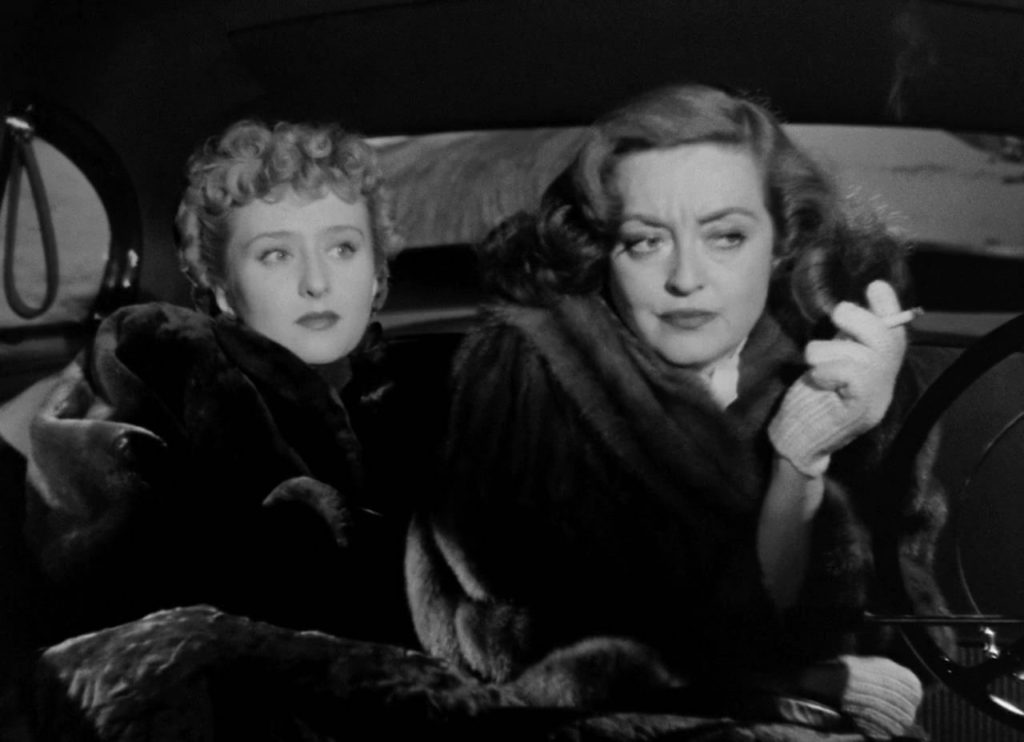
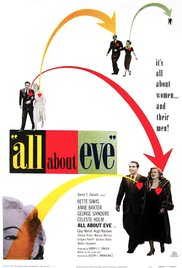 Outside of advancement of technology, there is probably no facet of film that shows its age quite like comedy. Maybe it is that comedic tastes and norms change so much, or it may be that what we find funny is just conditioned by our culture. Whatever the reason, it was with this thinking that I went into All About Eve (1950), expecting quality but from the distance of modernity. It turns out I couldn’t have been more wrong, as this is one of the more timeless, sharply written, and wonderfully acted films I have ever seen.
Outside of advancement of technology, there is probably no facet of film that shows its age quite like comedy. Maybe it is that comedic tastes and norms change so much, or it may be that what we find funny is just conditioned by our culture. Whatever the reason, it was with this thinking that I went into All About Eve (1950), expecting quality but from the distance of modernity. It turns out I couldn’t have been more wrong, as this is one of the more timeless, sharply written, and wonderfully acted films I have ever seen.
As the film opens on an awards ceremony for the Eve Harrington (Anne Baxter), a voiceover clues the audience in on who’s who and immediately the great writing is on full display. Written and directed by Joseph L. Mankiewicz, All About Eve reminded me of an episode of Aaron Sorkin’s The West Wing, where every character seems to walk around delivering wonderfully astute comments and speeches. Addison DeWitt (George Sanders), the narrator, introduces himself in one of my all time favorite film introductions: “To those of you who do not read, attend the theater, listen to unsponsored radio programs or know anything of the world in which you live – it is perhaps necessary to introduce myself. My name is Addison De Witt. My native habitat is the theater. In it, I toil not, neither do I spin. I am a critic and commentator. I am essential to the theater.”
The film details Eve’s rise to fame, but it is the quality of each of the roles that elevates the film. Bette Davis plays aging actress Margo Channing, aware of time’s effects but still ready to give as good as she got. Channing is smart, sensitive, goal-oriented, conceited, talented, brash, and a lot of other great characteristics and Davis plays her with a willingness to let the audience hate her but still oh, so human. She’s dating the director and worried he’s going to find someone younger, not realizing that he loves her for so much more than her looks. There’s also the playwright Lloyd Richards (Hugh Marlowe) and his wife Karen (Celeste Holm), who is responsible for introducing Eve into their world. Every character is humanized and realized wonderfully, and it isn’t a surprise that almost all were nominated for their work in the film. All About Eve holds the honor of having the most women nominated for a single film (four), though none won.
I watched All About Eve with my wife, who planned to mostly work and listen, but she gave up on that as the quality of the film became clear. We both loved it, and in thinking about how I would recommend it, I feel that it has a million hooks to satisfy most people. It is an insider look at the theater world, a mystery, a romance, satire and comedy. With only a few minor changes, it could have been written today, and I have little doubt it would be just as heralded.
Highly recommended, and don’t miss the Marilyn Monroe cameo, as this was just before she became a star and household name.
Gone With the Wind
(1939, MGM, dir. Victor Fleming, George Cukor, Sam Wood)
by Krystal Lyon
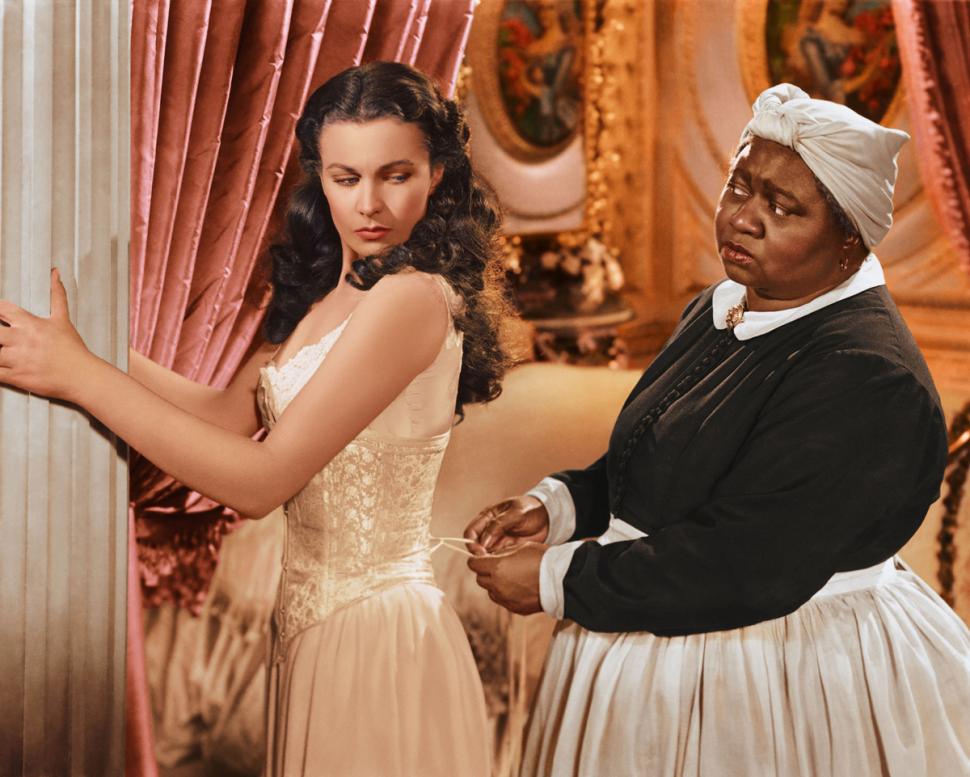
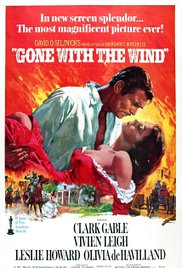 I know the point of “Film Admissions” is to admit that there are great movies out there that even film buffs have never watched and then watch said film and write about it. And, being the newbie around ZekeFilm and a film novice, I end up watching a bona-fide classic every time. (Examples… Dr. Strangelove, The Seventh Seal, From Here to Eternity, Double Indemnity and Alien. PS… Thanks ZekeFilm for giving me a great film education!) But this one hurts to admit: My “Film Admission” for February is Gone With the Wind! First, I’m from the South and I have spent more time in Atlanta, Georgia than any other large city. Second, I was a history major and specifically spent a year studying the Civil War and Reconstruction. And third, I read Gone With the Wind back in middle school when I spent my lunch hour in the library avoiding bullies and boys in general. There are multiple reasons why it was never watched: It’s really long, I’m not a big fan of Scarlett O’Hara, and most days I make mindless movie choices like Limitless. But the wrong has been righted and I have a couple observations to share.
I know the point of “Film Admissions” is to admit that there are great movies out there that even film buffs have never watched and then watch said film and write about it. And, being the newbie around ZekeFilm and a film novice, I end up watching a bona-fide classic every time. (Examples… Dr. Strangelove, The Seventh Seal, From Here to Eternity, Double Indemnity and Alien. PS… Thanks ZekeFilm for giving me a great film education!) But this one hurts to admit: My “Film Admission” for February is Gone With the Wind! First, I’m from the South and I have spent more time in Atlanta, Georgia than any other large city. Second, I was a history major and specifically spent a year studying the Civil War and Reconstruction. And third, I read Gone With the Wind back in middle school when I spent my lunch hour in the library avoiding bullies and boys in general. There are multiple reasons why it was never watched: It’s really long, I’m not a big fan of Scarlett O’Hara, and most days I make mindless movie choices like Limitless. But the wrong has been righted and I have a couple observations to share.
First of all it’s a stunner! Man, I wish, I wish, I wish that movies were made that still look this glamorous! From the grand scale and the ultra saturated colors to the magnificent costumes and vivid backdrops, David O. Selznick and MGM spared no expense, 3.9 Million in 1939, in making Gone With the Wind. And the Oscars that were won proved it was a cut above the rest. Gone with the Wind took home ten total Academy Awards and four of those were in the technical fields of Film Editing, Cinematography, Art Direction and a special Oscar for Outstanding Achievement in the Use of Color. Movies like Gone With the Wind are the reason I love going to the theater. The picture is almost too much to take in, like a visit to the Grand Canyon; you cannot register all that is taking place in front of you.
Secondly, the screenplay is pure gold! Even I knew the lines, “As God is my witness, I’ll never be hungry again!” and “I don’t know nothin’ ‘bout birthin’ babies!” and “Frankly, my dear, I don’t give a damn.” Everyone knew it was a well-told story; Margaret Mitchell’s Southern drama sold more than two million copies before the film was released. But the adapted screenplay by Sidney Howard, who won the Oscar posthumously in 1940, is a gem all on it’s own. To piece together the dialogue from a book that’s over 1,000 pages and to leave in wonderful lines like “You should be kissed and often, and by someone who knows how.” and adding in lines like “Good heavens woman, this is war not a garden party!” took a master. (Seriously can you imagine the task of turning that book into a film? Hands Raised Emoji to you Mr. Howard!)
And lastly, the acting is wonderful and even I fell for the Cad Rhett Butler! Selznick waited two years for Clark Gable to play the iconic role and it was worth it. I can’t imagine Errol Flynn, Gary Cooper or Groucho Marx as the wealthy playboy. And after a nationwide search and screen tests of over 1,400 actresses, Vivien Leigh won the role of the conniving drama queen Scarlett O’Hara. While I am not a fan of the character of Scarlett you can’t deny that Leigh was perfection. Then you have the serene and humble Melanie Hamilton played beautifully by Olivia de Havilland, who at 99 is still alive and lovely. Seriously, I feel like she glowed during her close-ups! All three, Gable, Leigh and de Havilland were nominated for Academy Awards, but only Leigh left with a statue. However, there was another winner from the cast of Gone With the Wind. Hattie McDaniel won the Oscar for Best Supporting Actress for the role of Mammy. If you have a moment YouTube her acceptance speech, it’s a treat! McDaniel was the first African-American to be nominated for and win an Academy Award. Her performance is solid and important, as is Butterfly McQueen’s role as Prissy and Eddie ‘Rochester’ Anderson’s role as Uncle Peter.
I’ve gone on entirely too long, but I think that’s appropriate with a book over a 1,000 pages and a movie that is almost four hours long. I can happily mark Gone With the Wind off the list and I might just watch it again. “After all, Tomorrow is another day.”
Wings
(1927, Paramount Famous Lasky Corporation, dir. William A. Wellman)
by Jim Tudor
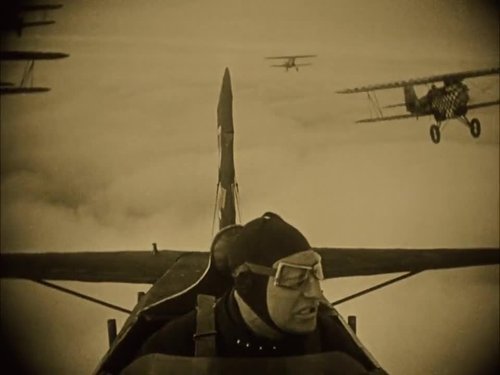
 Eye-popping vehicle-based action… A typically glamorous female lead actress being less than glamourous… A stylized, desolate landscape… Not a lot of talking… Yes, Wings, the Academy Award winning Best Picture of 1927, was the Mad Max: Fury Road of its day! And also like Fury Road, it’s a standout selection in its grouping, that grouping being Best Picture winners that actually deserved to win. (To be technical, Wings won “Best Production”, now considered the “Best Picture” equivalent of back then). But Wings isn’t just a solid Oscar winner, it was also the first. A silent film made at the peak of that era, it’s possible that the opportunity to salute it’s achievement on such a grand scale opened the door of acceptance to continuing the ceremony annually. This acclaim still matters, although the Oscars themselves were yet to be an institution. (In fact, the term “Oscar” wouldn’t be coined for several more years.) Case in point: Here we are talking about Wings
Eye-popping vehicle-based action… A typically glamorous female lead actress being less than glamourous… A stylized, desolate landscape… Not a lot of talking… Yes, Wings, the Academy Award winning Best Picture of 1927, was the Mad Max: Fury Road of its day! And also like Fury Road, it’s a standout selection in its grouping, that grouping being Best Picture winners that actually deserved to win. (To be technical, Wings won “Best Production”, now considered the “Best Picture” equivalent of back then). But Wings isn’t just a solid Oscar winner, it was also the first. A silent film made at the peak of that era, it’s possible that the opportunity to salute it’s achievement on such a grand scale opened the door of acceptance to continuing the ceremony annually. This acclaim still matters, although the Oscars themselves were yet to be an institution. (In fact, the term “Oscar” wouldn’t be coined for several more years.) Case in point: Here we are talking about Wings
Although the many deftly realized World War I ariel action sequences are truly spectacular, Wings maintains its vitality even during its quieter, and yes, melodramatic moments. This should come as no surprise, considering that the film was directed by William “Wild Bill” Wellman, an adventurer and visionary storyteller in his own right. Wings tells an epic yet intimate take that transpires in 1917, a moment of recent history for all involved. It’s the story of a pair of aviators (Charles Rogers & Richard Arlen, as unknown then as they are today), and the spirited young woman (Clara Bow, the biggest movie star of the time, commonly referred to as the “It girl”) who spends the film not just pining away for one of them, but selflessly pulling his fat out of the fire in his drunken moment of personal shame. Wings is also notable for launching the career of Gary Cooper, who shows up to steal one memorable scene.
The apparent pending doom of one of the male leads is played with a twist that is as tragic as it is implausible. But the latter aspect doesn’t matter so much. It’s Wellman’s spark and dedication to communicating the feel of his own wartime aviation experiences, something he does on an uncompromisingly grand scale. Wings‘ victory could be viewed as the last hurrah for its brand of brilliant silent filmmaking. The following year, with newfangled talkies being all the popular rage, the big award would go to the tough-to-get-through musical showcase The Broadway Melody. Wings is in many ways the very opposite, a fulfilling film on numerous levels. With its insistence on turning its actors into pilots, some of greatest ariel stunt work ever filmed, a dash of pre-code naughtiness, and its purely unforgettable recreation of the First World War, Wings earns the first Big Oscar with full fury.


